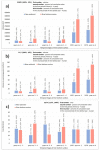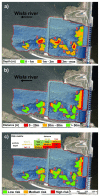Bathymetric Monitoring of Alluvial River Bottom Changes for Purposes of Stability of Water Power Plant Structure with a New Methodology for River Bottom Hazard Mapping (Wloclawek, Poland)
- PMID: 32899337
- PMCID: PMC7506780
- DOI: 10.3390/s20175004
Bathymetric Monitoring of Alluvial River Bottom Changes for Purposes of Stability of Water Power Plant Structure with a New Methodology for River Bottom Hazard Mapping (Wloclawek, Poland)
Abstract
The aim of this research was to produce a new methodology for a special river bottom hazard mapping for the stability purposes of the biggest Polish water power plant: Włocławek. During the operation period of the water power plant, an engineering-geological issue in the form of pothole formation on the Wisła River bed in the gravel-sand alluvium was observed. This was caused by increased fluvial erosion resulting from a reduced water level behind the power plant, along with frequent changes in the water flow rates and water levels caused by the varying technological and economic operation needs of the power plant. Data for the research were obtained by way of a 4-year geodetic/bathymetric monitoring of the river bed implemented using integrated GNSS (Global Navigation Satellite System), RTS (Robotized Total Station) and SBES (Single Beam Echo Sounder) methods. The result is a customized river bottom hazard map which takes into account a high, medium, and low risk levels of the potholes for the water power plant structure. This map was used to redevelop the river bed by filling. The findings show that high hazard is related to 5% of potholes (capacity of 4308 m3), medium with 38% of potholes (capacity of 36,455 m3), and low hazard with 57% of potholes (capacity of 54,396 m3). Since the construction of the dam, changes due to erosion identified by the monitoring have concerned approximately 405,252 m3 of the bottom, which corresponds to 130 Olympic-size pools. This implies enormous changes, while a possible solution could be the construction of additional cascades on the Wisła River.
Keywords: GNSS/SBES measurements; Poland; Wisła River; alluvial river bottom changes; bathymetric monitoring; river bottom hazard mapping; stability; water power plant structure.
Conflict of interest statement
The authors declare no conflict of interest
Figures













References
-
- Magirl C.S., Hilldale R.C., Curran C.A., Duda J.J., Straub T.D., Domanski M., Foreman J.R. Large-scale dam removal on the Elwha River, Washington, USA: Fluvial sediment load. Geomorphology. 2015;246:669–686. doi: 10.1016/j.geomorph.2014.12.032. - DOI
-
- Randle T.J., Bountry J.A., Ritchie A., Wille K. Large-scale dam removal on the Elwha River, Washington, USA: Erosion of reservoir sediment. Geomorphology. 2015;246:709–728. doi: 10.1016/j.geomorph.2014.12.045. - DOI
-
- Siqueira A.G., Azevedo A.A., Dozzi L. Engineering Geology for Society and Territory-Volume 3: River Basins, Reservoir Sedimentation and Water Resources. Springer International Publishing; Berlin/Heidelberg, Germany: 2015. Monitoring program of reservoir bank erosion at porto primavera dam, parana river, sp/ms, brazil; pp. 351–355.
-
- Babiński Z., Habel M. Hydromorphological conditions of the lower Vistula in the development of navigation and hydropower. Acta Energetica. 2013;2:83–90. doi: 10.12736/issn.2300-3022.2013206. - DOI
LinkOut - more resources
Full Text Sources

